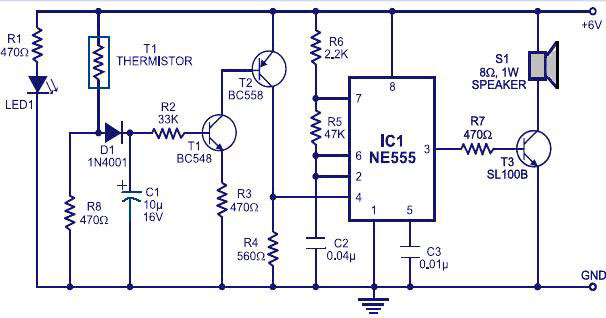
Pyroelectric Fire Alarm System Diagram

Pyroelectric Fire Alarm System Diagram. The front end of the circuit contains a sensitive signal amplifier constructed close to IC1 (CA3130). It delivers a high output when the temperature near the piezo component raises. IC CA3130 is a CMOS operational amplifier with gate-protected p-channel MOSFETs inside the inputs. It has high speed of operation and low input current specifications. There are two inputs: the non-inverting input (pin 3) is connected to the piezo component via diode D7 (OA71), which carries the voltage signal from the piezo component, and the inverting input (pin 2) receives a preset voltage through VR1. This is an ultra-sensitive fire sensor that exploits the direct piezoelectric property of an ordinary piezo component to recognize fire. The lead zirconate titanate crystals within the piezo component have the property to deform and produce an electrical potential when heated, thus converting the piezo component into a heat sensor. This is the shutter guard circuit, which has a sensitive vibration sensor, piezo-sensor. This circuit is specifically designed for outlets to defend against theft. It can recognize any mechanical or acoustic vibration in its area when someone attempts to break the shutter and instantly activate a lamp and sound an alert alarm. A 15-minute timer is included. This is the circuit diagram of a seismic/vibration sensor. The circuit simulates a seismic sensor to detect vibrations/sounds. It is very sensitive and may detect vibrations due to the motion of animals or human beings. Thus, it could be utilized to monitor protected locations to restrict the entry of undesirable individuals or animals. The circuit applies to fire alarms which use an LDR to sense smoke from a fire, allowing for the detection of dark smoke. With the onset of the summer season, the possibility of fire accidents increases. These fire accidents could be prevented if timely alarms are available. The circuit provided here alerts users accordingly. The following circuit is a simple fire alarm circuit based on the NE555 timer and uses a thermistor as a temperature detector. This sensor will activate the transistor when the temperature is high. The thermistor will have low resistance at high temperatures, while at low temperatures, the transistor resistance is high. This characteristic of the thermistor allows for temperature monitoring. The circuit also provides an output indicator of the temperature around the circuit. The indicator consists of two LEDs (D1 and D2), which indicate temperatures above and below 80 degrees Celsius. A well-known IC, LM35, is chosen as the temperature sensor in this circuit.
The pyroelectric fire alarm system diagram integrates multiple components to create a robust detection mechanism for both fire and unauthorized access. The primary component, the CA3130 operational amplifier, is crucial for amplifying the signal generated by the piezo component. This piezo sensor utilizes the piezoelectric effect of lead zirconate titanate crystals, which generate an electrical signal in response to temperature changes. The circuit configuration allows for a high output when temperature thresholds are exceeded, ensuring timely alerts in the event of a fire.
In addition to fire detection, the circuit features a shutter guard system that employs a piezo sensor to detect vibrations. This design is tailored to enhance security by monitoring for unauthorized entry through mechanical or acoustic vibrations. The system activates an alarm and illuminates a lamp when such disturbances are detected, providing immediate feedback to potential intruders.
Furthermore, the seismic/vibration sensor circuit is designed to monitor environmental vibrations, making it versatile for applications beyond fire detection. It can be employed in various settings to safeguard against unwanted intrusions by alerting users to movement in protected areas.
The integration of an LDR (Light Dependent Resistor) in the fire alarm system enhances its capability to detect smoke, particularly dark smoke, which is crucial in fire scenarios. This feature is especially relevant during warmer seasons when the risk of fire incidents escalates.
Lastly, the inclusion of a thermistor in the NE555 timer-based fire alarm circuit allows for precise temperature monitoring. The thermistor's resistance characteristics provide a reliable means to trigger an alarm at elevated temperatures. The dual LED indicators serve as a visual representation of temperature levels, enhancing user awareness of environmental conditions. The use of the LM35 temperature sensor further solidifies the circuit's reliability in monitoring and alerting users to potential fire hazards. Overall, this comprehensive approach to fire and security detection underscores the importance of integrating multiple sensing technologies in electronic circuit design.Pyroelectric Fire Alarm System Diagram. The front end of the circuit contains a sensitive signal amplifier constructed close to IC1 (CA3130). It delivers a high output when temperature near the piezo component raises. IC CA3130 is really a CMOS operational amplifier with gate protected p-channel MOSFETs inside the inputs.
It has high speed of oper ation and low input current specifications. There are certainly two inputs-the non-inverting input (pin 3) connected to the piezo component via diode D7 (OA71) that carries the voltage signal from the piezo component and the inverting input (pin 2) that gets a preset voltage through VR1. This is definitely an ultra-sensitive fire sensor that exploits the direct piezoelectric property of an ordinary piezo component to recognize the fire.
The lead zirconate titanate crystals within the piezo component have the property to deform and produce an electrical potential when heated, thus converting the piezo component into a heat sensor. The circuit mentioned. This is the shutter guard circuit which has sensitive vibration sensor, piezo-sensor. This circuit is specifically designed for outlets to defend towards theft. It can recognize any mechanical or acoustic vibration in its area when somebody attempts to break the shutter and instantly turn on a lamp and sound an alert alarm.
A 15-minute time. This is the circuit diagram of seismic / vibration sensor. The circuit simulates a seismic sensor to detect vibrations/sounds. It`s really sensitive and may detect vibrations due to the motion of animals or human beings. So it could be utilized to monitor protected locations to restrict entry of undesirable individuals or animals. The circuit applies. This is the fire alarm circuit which use LDR to sense the smoke from the fire, so it can be used to detect any dark smoke.
With the onset of summer season, possibilities of fire accidents go up. These fire accidents could be prevented if timely alarms are available. The circuit given right here alerts. The following circuit is a simple fire alarm circuit based NE555 timer and use thermistor as a temperature detector. This sensor will activate the transistor when the temperature is in high value. The thermistor will have a low resistance at high temperature, while at low temperature, the transistor resistance is high.
This characteristic of thermitor. This circuit is a circuit which will provide output indicator of the temperature around the circuit. The indicator is just 2 pieces LEDs (D1 and D2) which indicates the heat of above 80 degrees Celsius and below 80 degrees Celsius. A well-known IC LM35 is chosen to be the temperature sensor in this circuit. Output. 🔗 External reference
The pyroelectric fire alarm system diagram integrates multiple components to create a robust detection mechanism for both fire and unauthorized access. The primary component, the CA3130 operational amplifier, is crucial for amplifying the signal generated by the piezo component. This piezo sensor utilizes the piezoelectric effect of lead zirconate titanate crystals, which generate an electrical signal in response to temperature changes. The circuit configuration allows for a high output when temperature thresholds are exceeded, ensuring timely alerts in the event of a fire.
In addition to fire detection, the circuit features a shutter guard system that employs a piezo sensor to detect vibrations. This design is tailored to enhance security by monitoring for unauthorized entry through mechanical or acoustic vibrations. The system activates an alarm and illuminates a lamp when such disturbances are detected, providing immediate feedback to potential intruders.
Furthermore, the seismic/vibration sensor circuit is designed to monitor environmental vibrations, making it versatile for applications beyond fire detection. It can be employed in various settings to safeguard against unwanted intrusions by alerting users to movement in protected areas.
The integration of an LDR (Light Dependent Resistor) in the fire alarm system enhances its capability to detect smoke, particularly dark smoke, which is crucial in fire scenarios. This feature is especially relevant during warmer seasons when the risk of fire incidents escalates.
Lastly, the inclusion of a thermistor in the NE555 timer-based fire alarm circuit allows for precise temperature monitoring. The thermistor's resistance characteristics provide a reliable means to trigger an alarm at elevated temperatures. The dual LED indicators serve as a visual representation of temperature levels, enhancing user awareness of environmental conditions. The use of the LM35 temperature sensor further solidifies the circuit's reliability in monitoring and alerting users to potential fire hazards. Overall, this comprehensive approach to fire and security detection underscores the importance of integrating multiple sensing technologies in electronic circuit design.Pyroelectric Fire Alarm System Diagram. The front end of the circuit contains a sensitive signal amplifier constructed close to IC1 (CA3130). It delivers a high output when temperature near the piezo component raises. IC CA3130 is really a CMOS operational amplifier with gate protected p-channel MOSFETs inside the inputs.
It has high speed of oper ation and low input current specifications. There are certainly two inputs-the non-inverting input (pin 3) connected to the piezo component via diode D7 (OA71) that carries the voltage signal from the piezo component and the inverting input (pin 2) that gets a preset voltage through VR1. This is definitely an ultra-sensitive fire sensor that exploits the direct piezoelectric property of an ordinary piezo component to recognize the fire.
The lead zirconate titanate crystals within the piezo component have the property to deform and produce an electrical potential when heated, thus converting the piezo component into a heat sensor. The circuit mentioned. This is the shutter guard circuit which has sensitive vibration sensor, piezo-sensor. This circuit is specifically designed for outlets to defend towards theft. It can recognize any mechanical or acoustic vibration in its area when somebody attempts to break the shutter and instantly turn on a lamp and sound an alert alarm.
A 15-minute time. This is the circuit diagram of seismic / vibration sensor. The circuit simulates a seismic sensor to detect vibrations/sounds. It`s really sensitive and may detect vibrations due to the motion of animals or human beings. So it could be utilized to monitor protected locations to restrict entry of undesirable individuals or animals. The circuit applies. This is the fire alarm circuit which use LDR to sense the smoke from the fire, so it can be used to detect any dark smoke.
With the onset of summer season, possibilities of fire accidents go up. These fire accidents could be prevented if timely alarms are available. The circuit given right here alerts. The following circuit is a simple fire alarm circuit based NE555 timer and use thermistor as a temperature detector. This sensor will activate the transistor when the temperature is in high value. The thermistor will have a low resistance at high temperature, while at low temperature, the transistor resistance is high.
This characteristic of thermitor. This circuit is a circuit which will provide output indicator of the temperature around the circuit. The indicator is just 2 pieces LEDs (D1 and D2) which indicates the heat of above 80 degrees Celsius and below 80 degrees Celsius. A well-known IC LM35 is chosen to be the temperature sensor in this circuit. Output. 🔗 External reference





